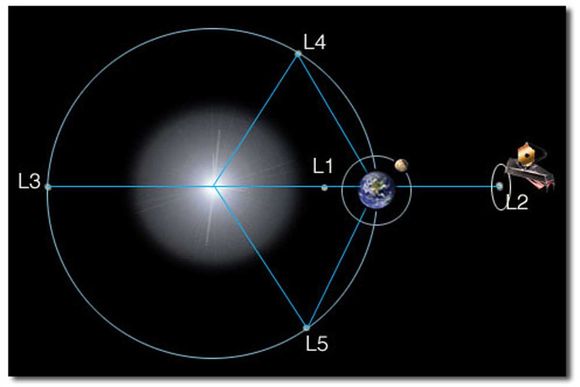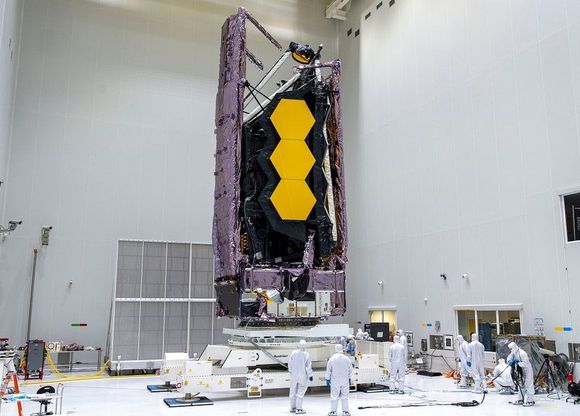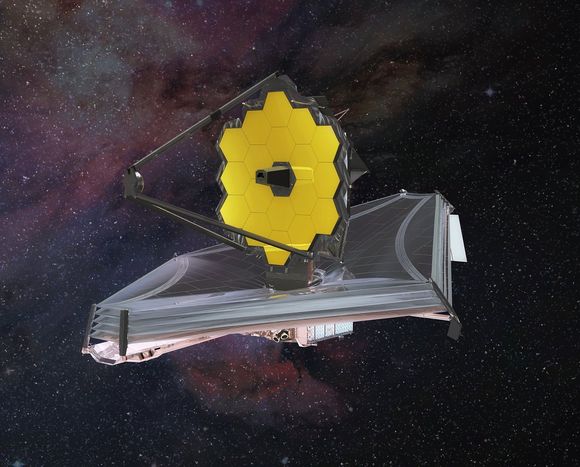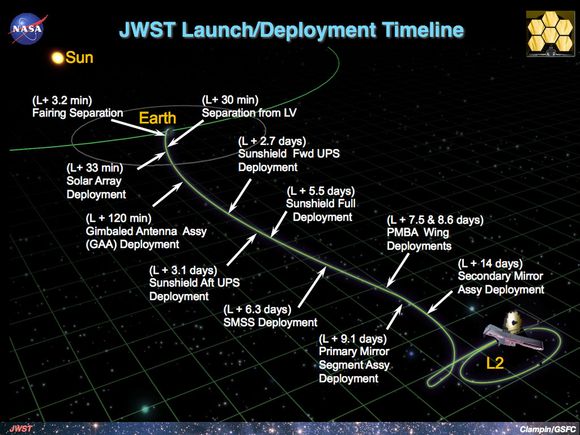Finally the successor to the Hubble Space Telescope - The James Webb Space Telescope (JWST) is (just) about ready for launch and by the New Year the instrument should have departed terra firma and have hopefully been safely delivered into its natural environment. To say the journey from planning board to final pre launch installation delivery has been anything but smooth would be a gross understatement. Even at the last minute, the launch has been delayed from December 18 to at least December 22 while science engineers investigate any possible effects following an "incident" which occurred during processing operations at the launch site in Kourou, French Guiana. It is here JWST will launch on an Ariane 5 rocket provided by the European Space Agency.
Originally conceived in the 1990's, the long gestation period of JWST has been tortuous, the original launch date set being 2007 with a budget of $ 3 billion. The project has been dogged with technological roadblocks, budgetary and even political rows; launch date after launch date came, and went, including one in March 2021. Inevitably delays cost money, whatever the reason, and advances in technology cost even more, but above all NASA's rigorous safeguard and checking regime for deployment really pushed the boat out! It has to, this is a one shot deployment mission, no going up to tinker with, or modify as in the case of HST, this has to work from the get-go. It's not surprising then that the price tag has soared to $10 billion.
What then do you get for $10 billion? Well for a start JW is by far the largest and most complex space telescope launched, with a segmented mirror equivalent to 6.5 meters (Hubble is just 2.4 metres). Each of the 18 x 1.32 metre hexagonal beryllium sub-mirrors is coated with a layer of gold to maximise reflectivity. Six of the mirrors fold away, so that JW can fit into the launch rocket vehicle. All of these mirrors have to deploy and then be aligned using sophisticated actuators so that 18 mirrors become just one. The secondary mirror, which is itself 0.74 metres wide, sits at the apex junction of 3 articulated booms and will be deployed 10 days after launch. The whole telescope observatory is shielded by a tennis court sized kite-shaped sunshield comprised of 5 separate membranes all kept taught by a management system of motor's, pulley's and wires!
Project managers have learned the lessons from HST mirror issues, and the JW mirror has already undergone rigorous full deployment procedures in environments very similar to those the scope will experience. Unlike HST which was placed in low Earth orbit for servicing purposes, the JWST will be deployed at what is known as lagrange point L2, this is 1.5 million km from Earth on the far side of the Moon and is where gravity from Earth, Sun and Moon are balanced out. At this point JW can sit and do science with minimal corrections.

The Lagrange L2 halo point 1.5 million km from Earth and location of JWST
The science JWST will be doing is ground breaking, and should revolutionise astronomy over its projected 10 year life span (hopefully). Initially JWST will concentrate on eight programmes;- Exo-planets and Disks; Galaxies; Intergalactic and Circumgalactic mediums; the large scale structure of the universe; Solar system observations; Stellar Physics and Types and populations; the Interstellar medium and Super massive Black holes and Active galaxy nuclei. We shall look at these in more detail next month, but when you consider that just for the Exosolar planet programme, JWST should be able to detect signs of a 'life supporting atmosphere' around a planet at distances out to ### light years, the implications of any such discoveries will have a profound impact, and may answer one of the great questions, are we alone?
This is speculation for the time being, JWST has many obstacles to clear. Thirty minutes after liftoff JWST will separate from launcher and the solar panel array will deploy. Twelve hours later thrusters will fire to fine tune its trajectory. Within a day the telescopes antenna will be deployed to communicate back to Earth and from days 3 to 7 the critical sunshield and membranes will be deployed. day 3 part of the sunshield pallet will be deployed. On day 9 the first instrument (MIRI) tests are carried out after the cryocooling process is started. On day 10 the secondary mirror support trusses are extended and a day later the Aft Deployed Instrument Radiator is unlatched. On day 12 one side of the primary mirror cells are unfolded, followed by the other side a day later, completing the deployment stages. The next ten days are spent activating and moving the mirror segments to optimum positions to act as one primary mirror. Finally on day 28 the JWST is placed in the optimum halo orbit at the L2 point.
Those first 30 days will be an extremely tense, nail biting, roller coaster of a ride, not only for the engineers and scientists directly and indirectly involved in the project, but also for many astronomers and scientists; professional and amatuer around the world. Following a six month commissioning phase, science observations will begin in earnest in the summer of 2022. Keep watching the media and keep fingers well and truly crossed; a whole slew of exciting discoveries are tantalisingly within touch!
- Log in to post comments



